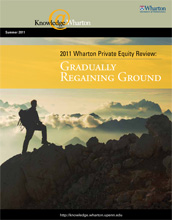From 2003 to 2007, when credit was easily accessible, multibillion dollar “megadeals” were commonplace. But in the post-leveraged buyout (LBO) era, characterized by more conservatively capitalized transactions, private equity firms are increasingly focused on middle-market companies — or those with annual revenues of $250 million to $1 billion — with strong management teams and strategies, according to panelists at the 2011 Wharton Private Equity and Venture Capital Conference.
Companies that “are doing well in their niche, but lack the skills to expand into new areas” are particularly attractive, according to Craig Bondy, a principal at GTCR Golder Rauner in Chicago. Private equity firms that acquire such companies can then apply strategic guidance and operational expertise, Bondy noted during the panel titled, “Middle Market: Identifying and Creating Sustainable Competitive Advantages.” Moderating the discussion was G. Daniel O’Donnell, who chairs the private equity group at the law firm Dechert LLC in Philadelphia.
Tight money is encouraging the move toward middle-market investing, said Michael Delaney, managing partner of Court Square Capital Partners in New York. With giant funds having trouble raising the cash for megadeals, “limited partners are gravitating to the middle market,” Delaney noted. Moreover, “There are a lot of questions in the limited-partner community about whether the mega-model [for funds] is viable,” he pointed out. “We will need to see how investments made in the late 2000s play out.”
Middle-market investors have greater flexibility when it comes to cashing out, Delaney added, since they can exit through public offerings or by finding a strategic buyer to acquire their positions. By contrast, a multibillion dollar private investment “might be performing well,” he noted, but the ability to exit from it “is tied to the general IPO markets.”
Private equity firms may have surprising exit routes, according to Benjamin Hochberg, partner at Lee Equity Partners in New York. He cited a specialty health care finance company that Lee funded in 2008 with $500 million of debt capital. Lee has introduced the company, which lends to middle-market health-oriented concerns, to banks that might want to acquire a health care finance unit “when they are ready.” While Lee is not actively selling this business, Hochberg said, he is “pretty confident” of exiting successfully.
Hochberg agreed that the middle market offers more flexibility to private equity investors than the larger market, and has more room for entrepreneurial moves. “What distinguishes the middle market is you can control your own destiny,” he said. “In the middle market, somebody can write a billion-dollar check for something that was ‘X’ and is not yet ‘Y,'” he noted, referring to a company’s growth potential. “It’s a little more fun than calling the equity capital desk [of a securities trading firm] to find out what the appetite is today in the public markets.”
Meanwhile, deal flow will remain slow in the first half of 2011 but will pick up in the second half, predicted Andrew Steuerman, co-director of the direct lending group at New York-based Golub Capital, which finances middle-market companies. Steuerman said the ability to borrow at low interest rates creates healthy spreads for finance companies like Golub and helps to generate funds for private equity deals. “The supply-demand balance is good now,” he noted, referring to the capital available for deals. “There is more competition. There aren’t new competitors, but [public equity firms] are getting healthier.”
‘Green Roots Growing’
While fundraising will remain “very challenging” in 2011, the investing environment is nonetheless “getting pretty attractive,”according to Sean Traynor, a member of the management committee at Welsh, Carson, Anderson & Stowe, a private equity firm in New York. “You’re starting to see green roots growing, and some significant trees and leaves,” Traynor said. “I think the overall economy, hopefully with the structural deficits improving, will continue to drive more confidence. Middle-market companies are well positioned to take advantage of that.”
On the negative side, Traynor noted that the recession and the financial crisis have left pension-and endowment-fund managers fearful of not having enough cash on hand to meet capital calls, and thus reluctant to finance new deals. He added that few private equity firms have provided their limited partners with even 5% returns on deals made during the recent private equity boom, putting added pressure on fund managers to be selective in future investments.
Nonetheless, pension- and endowment-fund managers are currently under pressure to “stretch” into higher-yielding investments, Traynor noted, and private equity has historically delivered such returns. But in order to get limited partners to reinvest, firms will have to demonstrate strong track records to “reinforce that there is a business strategy and a team and capabilities that warrant additional investments.” Traynor expects competition for private equity funds to heat up as investors start putting money back into financial markets. But he doesn’t look for the new dollars to drive up the valuation of private equity deals to “completely crazy levels.”
While the next round of fundraising for Welsh, Carson, Anderson & Stowe is still more than three years away,Traynor said, some private equity firms are now in the fund-raising market. They include Providence Equity Partners, a large firm in Providence, R.I. “The reason many of these firms are successful is that they’ve had good returns and long-standing relations with limited partners,” Traynor noted. “So I think that factor will be more important going forward.”
Traynor, whose firm has no energy holdings at present, pointed to the energy sector when moderator O’Donnell asked the panel to name industries that looked well-positioned for private equity investment. “If I had money and was starting a fund, energy is an area that has such tremendous wind at its back,” said Traynor. “That wind will be blowing now, and for all of our lives and then some,” he noted, thanks to the “increasing demands of emerging markets and, hopefully, a developing middle class around the world.”
Hochberg cited global trade as his top pick for investment. He said Lee Equity is looking for businesses that build supply chains between the United State and consumers and businesses around the world. For example, he suggested third-party logistics companies that provide transport, warehousing and other services for moving goods from country to country. “The consumer is no longer just in Cleveland,” said Hochberg. “We need to move products out.”
For Delaney, cyclical industries that were hard hit in the recession could be attractive investments. Cyclical industries typically include sectors such as construction and durable goods. While cyclicals may not be poised to boom, Delaney noted, they are climbing out of a downturn so deep that future returns will be strong.
General partners will begin to invest once cyclical companies begin to show solid sales growth, Delaney said. “Over the last 30 years, we’ve all made a killing in cyclical businesses coming out of downturns,” he noted. “Whether this cycle is cooperative, given the excess capacity out there, I don’t know,” he added. “But we are at the start [of] when cyclicals become more attractive.”
Changes in software licensing make the software sector attractive as well, according to Bondy of GTCR Golder Rauner. The industry formerly used what Bondy called a “lumpy” licensing model that led to irregular revenue flows. But with software now widely available to users from central — or “cloud-based”– sources, revenue is steadier and lenders have become more interested in financing software deals, he said.
Steuerman took what he called the “easy lay-up” by choosing health care as the top investment opportunity, despite uncertainty about the fate, and final design, of U.S. health care reform. Health care now accounts for 17% of the U.S. economy, Steuerman said, and is likely to grow to 20%. “The market is too big, even with the regulatory overhang, not to go after it,” he noted.



